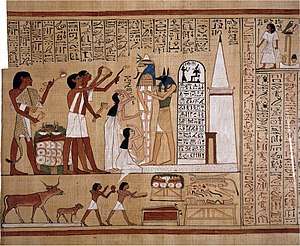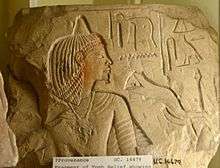Opening of the mouth ceremony
The opening of the mouth ceremony (or ritual) was an ancient Egyptian ritual described in funerary texts such as the Pyramid Texts.

Funerary magic


The ceremony involved a symbolic animation of a statue or mummy by magically opening its mouth so that it could breathe and speak. There is evidence of this ritual from the Old Kingdom to the Roman Period. Special tools were used to perform the ceremony, such as a ritual adze, an arm shaped ritual censer, a spooned blade known as a peseshkaf, a serpent-head blade, and a variety of other amulets. A calf's leg was also held up to the lips painted on the coffin.
The ancient Egyptians believed that in order for a person's soul to survive in the afterlife it would need to have food and water. The opening of the mouth ritual was thus performed so that the person who died could eat and drink again in the afterlife.
The ceremony involved up to 75 "episodes" and, in its most complete version, included the following stages:[1]
- Episodes 1–9 Preliminary rites
- Episodes 10–22 Animation of the statue
- Episodes 23–42 Meat offerings aligned with upper Egypt
- Episodes 43–46 Meat offerings aligned with lower Egypt
- Episodes 47–71 Funerary meal
- Episodes 72–75 Closing rites
The Book of the Dead also contains a spell for this process, which the deceased may use on themselves:[2]
My mouth is opened by Ptah,
My mouth's bonds are loosed by my city-god.
Thoth has come fully equipped with spells,
He looses the bonds of Seth from my mouth.
Atum has given me my hands,
They are placed as guardians.
My mouth is given to me,
My mouth is opened by Ptah,
With that chisel of metal
With which he opened the mouth of the gods.
I am Sekhmet-Wadjet who dwells in the west of heaven,
I am Sahyt among the souls of On.
Translating literally as "opening of the mouth," the Egyptian terms for the ritual are wpt-r and um-r. According to Ann Macy Roth, the verb wpi connotes an opening that splits, divides or separates: "it can be used, for example, to describe the separation of two combatants, the dividing of time, or even an analysis or determination of the truth."[3]
Connections with Psalm 51
Parallels between the Opening of the Mouth and Psalm 51 have been noted.[4] The parallels include:
- Mentions of ritual washing with special herbs (Psalm 51:2,7).
- Restoration of broken bones (verse 8).
- "O Lord, open thou my lips" (verse 15).
- Sacrifices (verses 16, 17, and 19).
See also
- Ancient Egyptian burial customs
References
- "The Opening of the mouth ritual". Archived from the original on 2014-08-22. Retrieved 2018-07-21.University College London
- Lichtheim, Miriam (1976). Ancient Egyptian Literature, vol 2. London, England: University of California Press. ISBN 0-520-02965-8.
- The ancient gods speak : a guide to Egyptian religion. Oxford University Press. 2002. p. 294. ISBN 0195154010.
- Benjamin Urrutia, "Psalm 51 and the 'Opening of the Mouth' Ceremony." Scripta Hierosolymitana: Publications of the Hebrew University of Jerusalem, volume 28, pages 222–223 (1982).